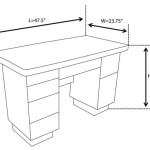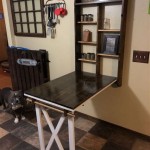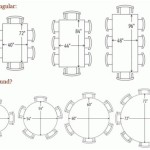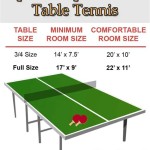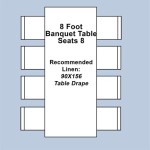Area Rug Size Guide for Dining Tables
Selecting the appropriate area rug size for a dining table is a critical element in interior design. A well-chosen rug can anchor the dining space, enhance its aesthetic appeal, and provide comfort underfoot. Conversely, an improperly sized rug can disrupt the visual harmony and create an awkward or uncomfortable dining experience. This article aims to provide a comprehensive guide to determining the ideal area rug size for various dining table dimensions and room layouts.
Understanding the Importance of Rug Size in Dining Rooms
The primary function of an area rug beneath a dining table is to define the dining area and provide a visual boundary. It serves as a foundation, creating a cohesive and inviting space. A rug that is too small can make the dining table appear disproportionately large, while a rug that is too large can overwhelm the room and detract from other design elements. Furthermore, the right rug size ensures that chairs can be pulled out and pushed back without catching on the rug's edge, preventing tripping hazards and protecting the flooring underneath.
Consider the flooring material. A rug can protect hardwood floors from scratches and dents caused by chair legs. In spaces with tile or stone flooring, a rug can add warmth and soften the overall ambiance. Ultimately, an appropriately sized rug enhances both the functionality and aesthetic of the dining area.
Key Considerations for Determining Rug Size
Several factors influence the ideal rug size for a dining table. These include the dimensions of the dining table itself, the shape of the table, the size and shape of the dining room, and the presence of other furniture in the area. Each of these factors must be carefully considered to achieve a balanced and harmonious design.
The shape of the rug should generally mirror the shape of the dining table. A rectangular table pairs well with a rectangular rug, a round table with a round rug, and a square table with a square rug. However, in some cases, a different rug shape can be used to create visual interest or to complement the overall room design. For instance, a round rug can soften the sharp angles of a rectangular dining room.
When measuring the rug, account for the distance chairs need to be pulled back from the table. The ideal rug is large enough so that all chair legs remain on the rug, even when the chairs are fully extended. This ensures a smooth and comfortable dining experience and prevents damage to the flooring.
Specific Rug Size Recommendations Based on Table Size
While general guidelines exist, the most accurate approach is to measure the dining table and add a specific amount of extra rug around each side. This ensures adequate space for chair movement and creates a balanced aesthetic. These recommendations are based on standard dining table sizes and configurations.
Round Tables:
- 4-foot Round Table: Requires at least a 9-foot round rug. This allows for approximately 2.5 feet of rug extending beyond the table's edge on all sides.
- 5-foot Round Table: Requires at least a 10-foot round rug. This provides adequate space for chair movement while maintaining visual balance.
- 6-foot Round Table: Requires at least an 11-foot or 12-foot round rug, depending on room size and chair dimensions.
Rectangular Tables:
- 4-foot x 6-foot Rectangular Table: Requires at least an 8-foot x 10-foot rug. This size ensures that chairs can be pulled out without slipping off the rug.
- 4-foot x 8-foot Rectangular Table: Requires at least a 9-foot x 12-foot rug. This larger size is necessary to accommodate the longer table length and provide ample seating space.
- 4-foot x 10-foot Rectangular Table: A 10-foot x 14-foot rug or even a 12-foot x 15-foot rug might be a better fit for larger dining rooms.
Square Tables:
- 4-foot x 4-foot Square Table: Requires at least an 8-foot x 8-foot square rug.
- 5-foot x 5-foot Square Table: Requires at least a 9-foot x 9-foot or 10-foot x 10-foot square rug. These rugs need to be adjusted based on the space they are in.
These are general guidelines, and adjustments may be necessary based on specific room dimensions and furniture arrangements. Always measure the available space and consider the overall aesthetic before making a final decision.
Dealing with Small Dining Rooms
In smaller dining rooms, prioritizing functionality is essential. While a large rug might be aesthetically pleasing, it may not be practical if it overwhelms the space. In these situations, consider a rug that is just large enough to accommodate the chair legs when the chairs are pushed in. This minimizes tripping hazards and creates a more open feel in the room.
Another approach is to opt for a rug that is slightly smaller than the recommended size but still provides some grounding for the dining table. This can be achieved by using a rug that extends approximately 18 to 24 inches beyond the table's edge on each side. This provides a visual anchor without overwhelming the small space. Using lighter colors and simpler patterns can also help create a sense of spaciousness.
Avoid using rugs that extend partially under adjacent furniture, as this can create a cluttered and disjointed look. The rug should either be entirely contained within the dining area or extend fully under the adjacent furniture to create a cohesive design.
Dealing with Large or Open-Concept Dining Rooms
In large or open-concept dining rooms, a larger rug can help define the dining area and create a sense of intimacy. A rug that is too small can get lost in the vastness of the space, making the dining table appear isolated. In these situations, consider a rug that extends well beyond the dining table and chairs, creating a generous seating area.
When working with open-concept spaces, the rug can also serve as a bridge between the dining area and adjacent living areas. Choose a rug that complements the color palette and style of both spaces to create a cohesive and harmonious design. Consider the visual weight of the rug and how it balances with other elements in the room, such as furniture and artwork.
Avoid using rugs that are too similar in color or pattern to the flooring, as this can create a monotonous and uninteresting look. Choose a rug that provides contrast and visual interest, while still complementing the overall design scheme. Large patterns or bold colors can add drama and personality to the space.
The Impact of Rug Material and Pile Height
The material and pile height of the rug can significantly impact its overall feel and functionality. In dining areas, rugs made from durable and easy-to-clean materials such as wool, synthetic fibers, or blends are generally preferred. These materials can withstand heavy foot traffic and are resistant to stains and spills. Consider the maintenance requirements of different materials before making a final decision.
Pile height refers to the thickness of the rug's fibers. Low-pile rugs are generally more practical for dining areas, as they are easier to clean and prevent chair legs from getting caught. High-pile rugs, while luxurious and comfortable, can be more difficult to maintain and may not be suitable for dining areas with heavy use.
The texture of the rug can also contribute to the overall aesthetic of the dining room. A textured rug can add visual interest and depth, while a smooth rug can create a more formal and elegant look. Choose a rug that complements the style of the dining table and chairs, as well as the overall design of the room.
Final Considerations
The ultimate goal is to create a dining space that is both visually appealing and functionally comfortable. By carefully considering the size, shape, material, and pile height of the area rug, one can transform a dining area into a welcoming and inviting space. Remember to measure the dining table and surrounding area accurately, and consider the overall design of the room before making a final decision. Always account for chair movement and ensure that the rug provides adequate space for comfortable seating.
The appropriate rug size not only anchors the table but also enhances the room’s ambiance. A well-proportioned rug can make a small room appear larger or define the dining space in an open-concept layout. It acts as a foundation, pulling together the design elements and creating a unified look. Select a rug that reflects personal style while serving a practical purpose, improving everyday dining experiences.

Expert Advice How To Design A Perfectly Scaled Dining Room Rug Size Layout Carpet

Pin On Apartment

How To Pick Rug Sizes Design Guide Dining Room Size Living Table

What Size Rug To Use For Your Dining Room

Rug Sizes For Dining Tables Chart Layout Designs Homely Rugs Room Size Round Table 6 Seater

Dining Room Rug Size Guide Arinsolangeathome

What Size Rug Under Dining Table Here S The Best Way To Find Righ

Rug Size Guide Ballard Designs

6 Rules For Choosing A Dining Room Rug Pretty Souces Stonegable

Rug Size Guide Choose The Right

